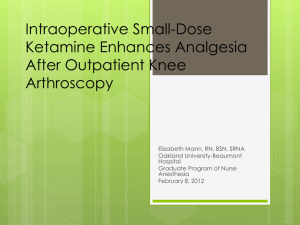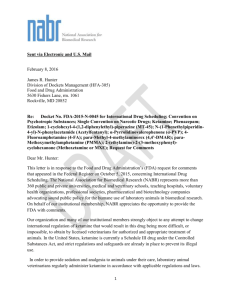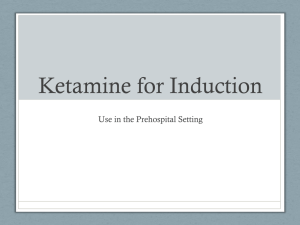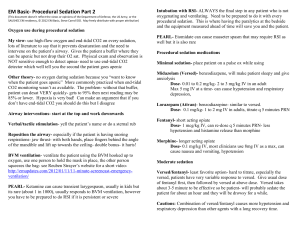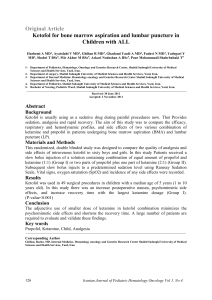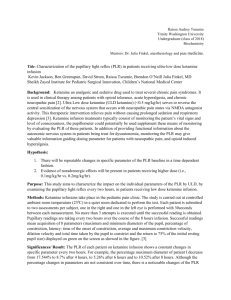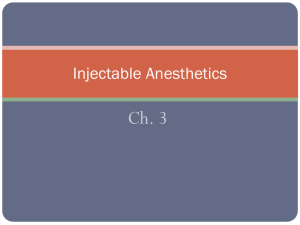SPVH - Advanced Anesthesia and Pain Management for Animals
advertisement
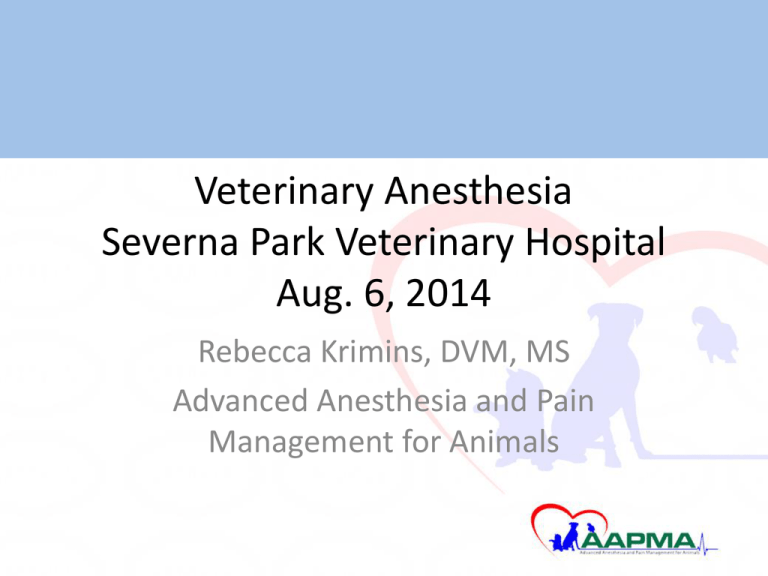
Veterinary Anesthesia Severna Park Veterinary Hospital Aug. 6, 2014 Rebecca Krimins, DVM, MS Advanced Anesthesia and Pain Management for Animals Topics • Anesthetic drugs • Pre-anesthetic combinations • Monitoring anesthetic depth Ketamine • Dissociative: dissociate the thalamocortic and limbic systemscataleptoid state (eyes open, swallow reflex intact) • Muscle rigidity • Decreases cardiac contractility • Increase peripheral vascular resistance decreases cardiac output Ketamine • NMDA-antagonistic properties (blocks glutamate) • Helpful with superficial pain, not useful for deep or chronic pain (poor visceral analgesia) • Helps prevent sensitization (windup) of nociceptive pathways Ketamine • Rapid onset (~ 5 minutes) • Moderate DOA (1-2 hours) • Stimulate sympathetic tone increased HR and BP • Induce salivation and airway secretions • Pain upon IM injection (low pH) • Some dogs show emergence delirium (uncoordinated movements of head/neck, voacalizations, salivation, agitation) Ketamine Pre-anesthetic Dosage • Dogs: 1-3 mg/kg IV, IM, SQ • Cats: 3-10 mg/kg IV, IM, SQ Ketamine • CRI dosage for intra-op pain: – 0.5 mg/kg IV bolus – 10 ug/kg/min CRI (lower doses for post-op) • Apnea in some (but generally is NOT a respiratory depressant) • Don’t administer with an anticholinergic • Associated with premature ventricular depolarizations Tiletamine • Dissociative • More potent than ketamine (3X), longer DOA • Produces sedation, immobility, amnesia, analgesia, muscle rigidity • (Zolazepam: similar to diazepam but is water soluble and more potent; can cause prolonged recovery in cats) Ketamine/valium and Tiletamine/zolazepam • Different neuroactive agents usedinduce anesthesia with the goal of achieving the highest quality of anesthesia with minimal side effects • Ketamine/valium – Ketamine 5 mg/kg IV – Diazepam 0.25 mg/kg IV • Tiletamine/zolazepam: (2-8 mg/kg IV, IM) – DOA: 20 min to one hour – Limited shelf-life after reconstitution – Induction: 1-3 mg/kg IV or 6-8 mg/kg IM Telazol Difference in Dogs vs Cats • Dogs: get a tiletamine hangover • Cats: get a zolazepam hangover Ket/Val (or Telazol) vs Propofol • Compared to propofol: – Less muscle relaxation – Increased salivation – Increased dysphoria • Good cardiopulmonary support – HR, CO, BP well maintained • Short duration Propofol • 2,6,-diisopropylphenol • Propofol: soybean oil, glycerol, egg phosphatide • Propoflo-28: benzyl alcohol • White emulsion: shake thoroughly (don’t mix with other drugs) • Metabolized by liver, extrahepatic sites of metabolism Propofol • • • • • Induction dose: 4-8 mg/kg IV Microdose under GA: 1-2 mg/kg IV Titrate to effect Duration of action: 10-20 minutes Advantages: rapid induction of GA, rapid metabolism, rapid emergence from GA, low incidence of nausea/vomiting Propofol • Disadvantages – Hypotension and cardiac depression – Respiratory depression – Pain on injection – Heinz body anemia in cats (repeated use) Dexmedetomidine • α-2 adrenergic agonist • Properties: sedative-hypnotic, analgesic, muscle relaxation – Anxiolysis, calming • Stimulate α2 receptors in braindecreased norepinephrine release • Dose-dependent CV effects: vasoconstrictionhypertensionreflex bradycardia Dexmedetomidine • Dosage: dependent on patient and procedure – IM: 5 ug/kg – IV: 1-2 ug/kg • Rapid onset (~ 5 minutes) • Moderate duration (~2 hours) • Atipamezole (reversal): – Give same volume as dexmedetomidine IM, SQ, IV Hydromorphone and Morphine • Pure mu opioids; excellent analgesics • Both drugs can cause excitement when used alone, in young, healthy animals • Both drugs will slow heart rate (increased vagal efferent activity) and cause respiratory depression • Profound sparing effect with induction and maintenance agents Hydromorphone vs Morphine • Hydromorphone: – SQ route associated with vomiting & panting – Doses > 0.1 mg/kg may produce hyperthermia – DOA: 1-4 hours • Morphine: – – – – – Can cause vomiting Associated with histamine release Excitement in cats Metabolites excreted by the kidneys DOA: 2-4 hours • Pupil size: miosis and mydriasis – Miosis (dogs) – Mydriasis (cats) Hydromorphone and Morphine • Hydromorphone dosages (SQ, IM, IV) – SQ: 0.1 mg/kg (DOA: 1-4 hours) – IV: 0.05 mg/kg (DOA: 1-2 hours) • Morphine (SQ, IM, IV) – IM: 0.2-0.6 mg/kg – IV: 0.1-0.5 mg/kg • Naloxone (reversal) 1-10 ug/kg IV – Take 1 ml naloxone, dilute with 9ml saline, titrate 1 ml/min to effect Pre-anesthetic Combinations • Think about: – Procedure: surgical vs diagnostic vs other – Level of pain involved in procedure – Duration of procedure – Patient status – How much time do you have Pre-anesthetic Combinations • • • • • Opioid +/- benzodiazepine +/- α2- agonist +/- phenothiazine +/- anticholinergic How to Monitor Anesthetic Depth • No single parameter tells you how light/deep – Gather all information together (patient, normals, disease states, drugs, procedure type and duration) • Must know parameter normals in order to be able to identify abnormals – Temp, pulse, RR, BP – SBP > 140 mmHg = light – SBP < 80 mmHg = deep How to Monitor Anesthetic Depth • Interact with patient • Every 5 minutes, check palpebral reflex (corneal reflex) and jaw tone; position of eye; check for signs of movement, muscle twitching, neck tone • Maintain body temperature • Vaporizer setting for past 15 minutes = ? Questions Email: drkrimins@gmail.com Advanced Anesthesia and Pain Management for Animals www.aapma.com
